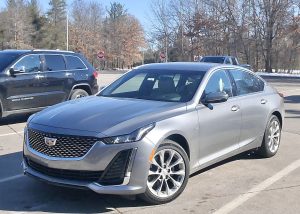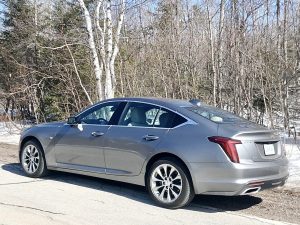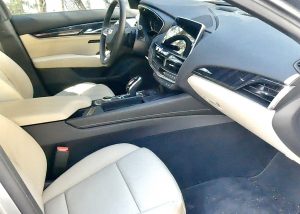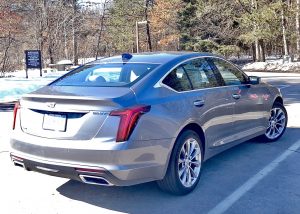Cadillac refines CT5’s look, tech
By John Gilbert
In the face of ever-decreasing competition, Cadillac has a far easier time of accepting praise that the stylish 2021 Cadillac CT5 sedan is the best-looking American sedan. We’re talking sedans from American companies — General Motors, Ford, and the company formerly known as Chrysler.
The fleets of sedans from those companies is smaller than ever, and apparently getting smaller still in years to come, and even General Motors has cut back on the number of sedans from Chevrolet and Buick. Cadillac, meanwhile, if forging onward and upward with its CT4 and CT5 mainstays, which have been improved distinctly over the last two years.
With new technology under the hood and new smoothed shape with styling that is less erector-set, sharp-edge lines and more aero-Euro-classy, the CT5 I recently test-drove checks all the boxes for style and performance, especially because it comes in an assortment of flavors. The top performer is the CT5-V Series, while the test-vehicle I had was the CT5 “Premium Luxury” model, which leaves off a few of the high-performing suspension and big-wheel/tire combinations of the CT5-V, trading them for a little more compliant ride, and quite a few more luxury touches inside.
From the outside, the test CT5 stands out because of the curvaceous body panels, and also because the “Satin Steel Metallic” paint does an artistic job of capturing every passing ray of light and converting it into an almost-liquid appearance. In recent months, I’ve also reported on a 2020- CT5-V Series in a fantastic, dark Evergreen, and last year’s CT4 in Garnet Red. Let’s just say that Cadillac seems to be focused on putting some stunning paint schemes on its latest vehicles.
It’s a major compliment to note that at a glance, a lot of passers-by will guess that the CT5 must be German — probably a Mercedes, or maybe a BMW or Audi. But that’s only until you walk around to the front, leaving the neatly contoured side panels and the well-done rear. The front has the now-distinctive Cadillac grille’s trapezoidal shape, blended artfully into the LED headlight enclosures.
But just being considered “one of the boys” among the top German luxury sedans is high praise, and the Cadillac doesn’t disappoint once you climb inside.
The firmly supportive leather bucket seats welcome you, and the 14-way adjustable settings mean you will be able to find however much comfort you can stand, and the steering wheel, loaded as it is with redundant controls for the audio system, climate, and racking over the on-board computer readouts, also has shift paddles affixed to the backside of the wheel so you can upshift or downshift the 10-speed transmission at the touch of a finger.
Push the starter button and fire-up the engine, and you might think the huge V8 has been quieted down a bit, but actually it is not a giant V8, but instead a plenty potent 3.0-liter V6, with dual overhead-camshafts and twin turbochargers to develop 360 horsepower, and pour it through the system to all four wheels.
The suspension is never harsh — much less harsh than the CT5-V Series, for example — but it is firm enough to satisfy a performance-oriented driver while cornering hard or following some tight curves aggressively.
Interesting blend, Cadillac has developed for both the CT4 with its turbo-four-cylinder power, lighter weight and smaller overall size, and for the CT5, which can be had hot of mild, with the understanding that the hotter CT5-V Series is comfortable enough and the CT5 “Premium Luxury” model is a strong-enough performer.
Somebody has to get into the inner offices at Cadillac and ask them to perhaps define the difference between “Premium” and “Luxury,” because to me they mean the same, and more of the same. But the excess seems to work, and may help justify the quite moderate sticker price of $51,455. The base price is $40,795, and the added option list includes the vital pieces — the 3.0 V6, all-wheel drive, and the suite of safety stuff such as lane-departure warning, following distance, and lane-keep assist, which gently guides you back into your lane if you’ve seemed to wander.
The biggest different between the CT4 and CT5 is the extra length, which translates into considerably more rear head and leg room in the CT5, while the large trunk awaits enough luggage to serve the four occupants for lots of miles or days.
With the biggest upgrades coming in the 2020 model year, Cadillac could focus on tightening up the steering and handling and find a few more luxury gadgets to install. It will get up to the EPA highway maximum 26 miles per gallon without much difficulty. We drove the freeway from Duluth to the Twin Cities and returned in the same day, and the trip computer showed 25.5 miles per gallon.
Not bad for a large, luxury vehicle. All the time I was driving the CT5 I couldn’t help but think this 3.0 Twin Turbo V6 is undoubtedly the highest-tech engine ever put in a Cadillac, but remember, Cadillac has said all of its cars will be pure electric by 2025. Makes me wonder if Cadillac might sublet a few of these DOHC V6es to its close personal friends at Chevrolet.







 John Gilbert is a lifetime Minnesotan and career journalist, specializing in cars and sports during and since spending 30 years at the Minneapolis Tribune, now the Star Tribune. More recently, he has continued translating the high-tech world of autos and sharing his passionate insights as a freelance writer/photographer/broadcaster. A member of the prestigious North American Car and Truck of the Year jury since 1993. John can be heard Monday-Friday from 9-11am on 610 KDAL(www.kdal610.com) on the "John Gilbert Show," and writes a column in the Duluth Reader.
John Gilbert is a lifetime Minnesotan and career journalist, specializing in cars and sports during and since spending 30 years at the Minneapolis Tribune, now the Star Tribune. More recently, he has continued translating the high-tech world of autos and sharing his passionate insights as a freelance writer/photographer/broadcaster. A member of the prestigious North American Car and Truck of the Year jury since 1993. John can be heard Monday-Friday from 9-11am on 610 KDAL(www.kdal610.com) on the "John Gilbert Show," and writes a column in the Duluth Reader.